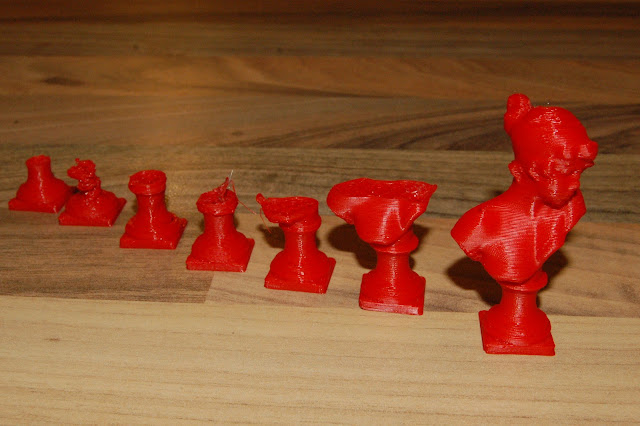I put an entry into the Weekly Print Competition taking place on the RepRap Forum. It was a great learning experience to enter something like this and brought the standard of my printing on immensely. The biggest challenge for me in printing this little object was to develop a good approach to cooling. Here's the final print I submitted, and some detail on the process.
It only stands 54mm high in reality, and quite a challenge to print. The STL is on Thingiverse if you want to give it a go. My Slic3r settings were as follows:
; generated by Slic3r 0.7.1 on 2012-05-29 at 22:59:22
; layer_height = 0.25
; perimeters = 2
; solid_layers = 2
; fill_density = .15
; nozzle_diameter = 0.35
; filament_diameter = 1.74
; extrusion_multiplier = 1
; perimeter_speed = 15
; infill_speed = 30
; travel_speed = 130
; extrusion_width_ratio = 0
; scale = 1
; single wall width = 0.39mm
Here's a view from a different angle...
The biggest challenge I faced was cooling the print as it was printing. The iterations of my cooling process development are well illustrated by the many failures I had before I finally printed the object successfully.
My particular 'home-brew' hotend is difficult to keep hot at the best of times, so when I was faced with having to blow cool air on the object being printed it was robbing heat from the heater block faster than the resistor could generate it. Many forms of directs fan arrangements failed. I printed a few of the cooling duct solutions found on Thingiverse, but eventually finished up with a highly modified version of one of those ducts I based my fan duct on the lower part of this design. It actually failed after the lower section (due to lack of cooling!) so I completed the mock up with cardboard and hotmelt glue, and some light metal sheet I had. To get on with the job quickly I simply hot-melted the fan duct to the x-carriage.
Here's a photo of my 'hack job' cooling solutions.
It had vents exiting directly downwards (seen hear from beneath, via the mirror printbed), but I closed those vents off, and used a heated nail to punch a series of holes in the inward facing walls of the duct. This directed air very specifically on to the freshly printed work area, and gave focused cooling. It also minimised cooling of the hot-end.
I had to add additional insulation to my hotend to minimise heat loss from the cooling process. I used strands of glass rope wrapped around the nozzle. My hotend already has a PTFE jacket!
Here's a short video clip of the final stages of the Sapphos print...
Thanks for viewing!
NumberSix










